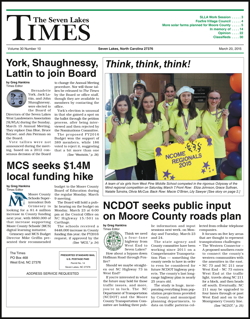 "I want people to step back and look at the whole document," Seven Lakes Landowners Association [SLLA] President Randy Ziesldorf told The Times in an interview on Friday. "If you look at the whole document, the Club's covenants are absolutely consistent with that document."
"I want people to step back and look at the whole document," Seven Lakes Landowners Association [SLLA] President Randy Ziesldorf told The Times in an interview on Friday. "If you look at the whole document, the Club's covenants are absolutely consistent with that document."
The document that Zielsdorf wants his membership to take a big-picture view of is the 2007 Agreement between the SLLA and Seven Lakes Country Club [SLCC] that aimed to put an end to controversy surrounding the Club's plan to sell its old driving range to a residential developer.
That agreement called for the Club to develop a set of covenants protecting its property. Those covenants were filed with Moore County on February 15, more than three-and-one-half years after the 2007 agreement was signed.
In a story published online on Thursday, March 10, The Times reported that those covenants fail to restrict the use of SLCC property to "the operations of the golf course and country club," as called for in the 2007 Agreement.
In 2007, Zielsdorf, along with his fellow SLLA directors Laura Douglass and Don Truesdell, said publicly that they supported the Agreement because it would prevent the Club's fairways and greens from ever being carved up into residential building lots.
"The most clearly worded statement"
What changed Zielsdorf's mind about the implications of the 2007 Agreement, he told The Times, was careful scrutiny, earlier this week, of the fourth point of the document, which reads: "Upon the sale of any Seven Lakes Country Club property for residential purposes such properties will be subject to the South Side Covenants."
Highlighting the phrase "any Seven Lakes Country Club property" and noting that "properties" is expressed in the plural, Zielsdorf told The Times: "It implies the Club would be selling something other than the old driving range for residential development."
"Number four is wide open; it could mean any country club property," Zielsdorf said. "I don't know how anyone can read bullet point number four and not interpret it this way."
"Maybe I should have been paying a little more attention to this four years ago," he added. "But this has been out there for four years. I think, in the haste, everyone has read this to think that it is only about the old driving range."
In an email to his fellow Board members that was forwarded to The Times, Zielsdorf writes: "If anything, bullet #4 is the most clearly worded statement in the July 2007 document."
He goes on to say, "Like it or not, the wording in the CC Covenants is consistent with the wording of the original July 2007 agreement. [SLLA Attorney Hunter] Stovall's value to the association was that he emphasized that "should" any CC property be developed, that it must fall under the South Side Covenants. This is emphasized in the CC covenants."
Zielsdorf's email also indicates that, from his perspective, the matter of the Club's covenants is closed, so far as the Association is concerned. "In light of the recent flap," Zielsdorf writes, "if the CC wants to revisit their covenants that is entirely their business, the SLLA should take no further action on this."
"Better than the original agreement"
The Times also re-interviewed Attorney Stovall on Friday. Asked specifically about the fourth bullet point of the agreement, Stovall was less interested in focusing there than in directing attention to the overall content of the document.
"Looking at this thing, I can restate what I have already told you," Stovall said. "If you look at [points] 1,4, and, to some extent, 5 . . the meaning of this -- and I think it is consistent with their [the SLLA Board's] discussion and their document -- it's that they [SLCC] would run it as a country club and golf course as long as they ran it; and, if they sold it, it would only be for residential purposes, and it would be covered by the South Side covenants."
"If you take just bullet point #1," Stovall continued, "it's not consistent. But if you take the four corners of the document, the agreement is consistent with our final product."
"We don't want to take a phrase or one sentence and try to hang too much on that," he said. "If you look at [bullet point] one, you're looking at just one part of the agreement."
"They are to run it as a golf course. If they stop running it as a golf course,they can sell it for residential development -- they have eliminated selling it for anything else."
"I'll stand by the fact that the covenants reflect the original agreement," Stovall told The Times. "If anything, the country club prepared a document that really was better -- the final result was better than the original agreement."
Opportunity for Amendment
Unlike the covenants that govern the rest of the property inside the North and South Side Gates, the SLCC's new covenants give the Club the right to easily amend the document, as long as that amendment is done in accordance with "the By Laws of the Declarant," i.e., the Country Club's by laws.
The Times asked Stovall whether this meant the Country Club Board or membership could, at some later date, decide to lift the restrictions limiting the property to residential development, in order to allow some sort of commercial development of the property.
"They can't come in and say, we're going to change the covenants to eliminate the coverage of the South Side covenants," Stovall replied. "My feeling is they are precluded from changing that based on the language of the document."
On the other hand, he added, "People do things they aren't authorized to all the time."
